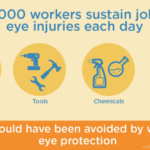
Post-pandemic, working remotely is the norm for millions of displaced Americans who now work part- or full-time in their homes. Extended periods in front of screens has caused remote and desk job office workers alike to increasingly suffer symptoms of digital eye strain. Though no association exists between digital eye strain and irreparable damage to one’s vision, all who work for extended periods on a computer must remain keenly attuned to low-level eye pain, headaches, and dry, red eyes. Equally, those working in industrial settings must stay vigilant in protecting their eyes, in part through ensuring they are issued the goggles, protective glasses and other eye wear necessary to protect against chemical, environmental, radiological or mechanical irritants and other commonplace hazards.
To emphasize the simple practices that both desk/computer and industrial setting workers can adopt to keep eyes well-protected on the job, the American Academy of Ophthalmology (AAO) has designated March as Workplace Eye Wellness Awareness Month! In March, desk-sitting professionals are encouraged to review the AAO’s tips for preventing digital eye strain when facing extended screen time. The AAO’s preventive are equally critical for professionals whose are employed at higher-risk worksites, where avoidable accidents can cause permanent damage to vision, even blindness, when protective eyewear is not worn.
Workplace Eye Wellness
1) Taking breaks is good eye health. It’s standard practice for professional desk sitters to break up long sedentary periods with a stretch break and wellness walks to clear the head. When you disengage from staring at a screen, giving your eyes a rest is just as vital to whole body health as motion intervals are to musculoskeletal health.
2) Follow the 20-20-20 rule: Set a timer as a reminder to look 20 feet away every 20 minutes for 20 seconds. This can be as simple as looking away from your computer screen or out the window. If virtual meetings keep you in your seat for extended time, shut your eyes for 20 seconds.
3) Practice eye ergonomics. Sit 18 to 25 inches away from your computer screen, about an arm’s length. Adjust screen brightness and contrast so that it feels comfortable. Position the screen so your eyes gaze slightly downward, not straight ahead or up.
4) Use eye drops. Artificial tears are the answer for many individuals whose quality of life is challenged by dry eye discomfort. Discuss recommended types and brands of over-the-counter eyedrops that can be purchased without a prescription.
- Humidifiers = moisture. If you work or live in a low moisture setting, buying a humidifier is a wise investment. These small misting devices are ideal to help people who live in high pressure cold areas or use indoors heaters that can create exceptionally dry indoor environments.
- Discuss computer glasses with your eye specialist. If you have trouble seeing your screen, talk to your optometrist or the optical shop about computer lenses, which are specifically designed for focusing on screens 20 to 26 inches away. Skip the blue light-blocking glasses. No scientific evidence has shown that blue light from a screen causes digital eye strain or damages the eye.
- Wear protective eyewear higher-risk worksite jobs: In construction, manufacturing facilities and other worksites where the risk of workplace accidents is higher, wearing appropriate eyewear on the job is critical. Protective eyewear has been estimated to prevent more than 90% of serious eye injuries that cost businesses across the U.S. nearly $300 million annually in lost productivity, medical treatment and worker compensation.
#WorkplaceEyeWellnessMonth @academyeyesmart
#ophthalmology #eyes
